Influence of Heat Treatment on the Mechanical Properties of Fine-Grained Granite under Dynamic Impact Loading
Abstract
1. Introduction
2. Heat-Treated Granite Specimen Preparation, Experimental Apparatus, and Experimental Scheme
2.1. Heat-Treated Granite Specimen Preparation
2.2. Experimental Apparatus
2.3. Experimental Scheme
3. Dynamic Properties of the Heat-Treated Granite under Impact Loading
3.1. Impact Stress–Strain Curve
3.2. Average Strain Rate
3.3. Peak Stress
3.4. Peak Strain
3.5. Elastic Modulus
3.6. Maximum Strain
4. Thermal Damage Characteristics
4.1. Analysis of XRD Test Results
4.2. Analysis of Scanning Electron Microscopy Results
5. Conclusions
Author Contributions
Funding
Data Availability Statement
Conflicts of Interest
References
- Zhou, W.; Lin, J.; Balint, D.S.; Dean, T.A. Clarification of the effect of temperature and strain rate on workpiece deformation behaviour in metal forming processes. Int. J. Mach. Tools Manuf. 2021, 171, 103815. [Google Scholar] [CrossRef]
- Sas-Boca, I.M.; Frunză, D.; Popa, F.; Ilutiu-Varvara, D.A.; Tintelecan, M.C. Influence of Temperature and Strain Rate on Microstructure and Fracture Mechanism of Mild Steel. Procedia Manuf. 2020, 46, 891–898. [Google Scholar] [CrossRef]
- Wang, Z.; Hao, S. Study on dynamic compressive mechanical properties and failure modes of heat-treated granite. Lat. Am. J. Solids Struct. 2017, 14, 657–673. [Google Scholar] [CrossRef]
- Wang, Z.L.; Hao, S.Y.; Zheng, J.; Tian, N.C.; Zha, F.S.; Shi, H. Study on energy properties and failure behaviors of heat-treated granite under static and dynamic compression. Mech. Adv. Mater. Struct. 2019, 27, 462–472. [Google Scholar] [CrossRef]
- Huang, S.; Xia, K.W. Effect of heat-treatment on the dynamic compressive strength of Longyou sandstone. Eng. Geol. 2015, 191, 1–7. [Google Scholar] [CrossRef]
- Liu, S.; Xu, J. Mechanical properties of Qinling biotite granite after high temperature treatment. Int. J. Rock Mech. Min. Sci. Geomech. Abstr. 2014, 71, 188–193. [Google Scholar] [CrossRef]
- Yang, S.-Q.; Li, Y.; Ma, G.-W.; Sun, B.-W.; Yang, J.; Xu, J.; Dai, Y.-H. Experiment and numerical simulation study of dynamic mechanical behavior of granite specimen after high temperature treatment. Comput. Geotech. 2023, 154, 105111. [Google Scholar] [CrossRef]
- Wang, Z.; Shi, G. Effect of heat treatment on dynamic tensile strength and damage behavior of medium-fine-grained huashan granite. Exp. Tech. 2017, 41, 365–375. [Google Scholar] [CrossRef]
- Wang, Z.L.; Shi, G.Y.; Wang, J.G.; Zhang, Z.H. Analysis of energy properties and failure modes of heat-treated granite in dynamic splitting test. Geotech. Test. J. 2018, 41, 235–246. [Google Scholar] [CrossRef]
- Yao, W.; Xu, Y.; Wang, W.; Kanopolous, P. Dependence of dynamic tensile strength of longyou sandstone on heat-treatment temperature and loading rate. Rock Mech. Rock Eng. 2016, 49, 3899–3915. [Google Scholar] [CrossRef]
- Yin, T.; Li, X.; Xia, K.; Huang, S. Effect of thermal treatment on the dynamic fracture toughness of laurentian granite. Rock Mech. Rock Eng. 2012, 45, 1087–1094. [Google Scholar] [CrossRef]
- Wang, Z.; Tian, N.; Wang, J.; Liu, J.; Hong, L. Experimental study on damage mechanical characteristics of heat-treated granite under repeated impact. J. Mater. Civ. Eng. 2018, 30, 275–296. [Google Scholar] [CrossRef]
- Wang, Z.; Tian, N.; Wang, J.; Yang, S.; Liu, G. Mechanical response and energy dissipation analysis of heat-treated granite under repeated impact loading. Comput. Mater. Contin. 2019, 59, 275–296. [Google Scholar] [CrossRef]
- Dai, J. Dynamic Behaviors and Blasting Theory of Rock; Metallurgy Industry Press: Beijing, China, 2002. (In Chinese) [Google Scholar]
- Bischoff, P.H.; Perry, S.H. Compressive behaviour of concrete at high strain rates. Mater. Struct. 1991, 24, 425–450. [Google Scholar] [CrossRef]
- Siviour, C.R.; Grantham, S.G. High resolution optical measurements of specimen deformation in the split Hopkinson pressure bar. Imaging Sci. J. 2009, 57, 333–343. [Google Scholar] [CrossRef]
- Bieniawski, Z.; Bernede, M. Suggested methods for determining the uniaxial compressive strength and deformability of rock materials. Int. J. Rock Mech. Min. Sci. Geomech. Abstr. 1979, 16, 138–140. [Google Scholar] [CrossRef]
- Zhou, Y.X.; Xia, K.W.; Li, X.B. Suggested methods for determining the dynamic strength parameters and mode-I fracture toughness of rock materials. Int. J. Rock Mech. Min. Sci. 2012, 49, 105–112. [Google Scholar] [CrossRef]
- Dai, F.; Huang, S.; Xia, K.; Tan, Z. Some fundamental issues in dynamic compression and tension tests of rocks using split hopkinson pressure bar. Rock Mech. Rock Eng. 2010, 43, 657–666. [Google Scholar] [CrossRef]
- Davies, E.; Hunter, S. The dynamic compression testing of solids by the method of the split Hopkinson pressure bar. J. Mech. Phys. Solids 1963, 11, 155–179. [Google Scholar] [CrossRef]
- Gray, G.T. Classic split-Hopkinson pressure bar testing. In Mechanical Testing and Evaluation; ASM International: Almere, The Netherlands, 2000; Volume 8, pp. 1027–1067. [Google Scholar]
- Yang, S.-Q.; Ranjith, P.; Jing, H.-W.; Tian, W.-L.; Ju, Y. An experimental investigation on thermal damage and failure mechanical behavior of granite after exposure to different high temperature treatments. Geothermics 2017, 65, 180–197. [Google Scholar] [CrossRef]
- Nasseri, M.; Schubnel, A.; Young, R. Coupled evolutions of fracture toughness and elastic wave velocities at high crack density in thermally treated Westerly granite. Int. J. Rock Mech. Min. Sci. Geomech. Abstr. 2017, 44, 601–616. [Google Scholar] [CrossRef]
- Li, X.; Lok, T.; Zhao, J.; Zhao, P. Oscillation elimination in the Hopkinson bar apparatus and resultant complete dynamic stress–strain curves for rocks. Int. J. Rock Mech. Min. Sci. Geomech. Abstr. 2000, 37, 1055–1060. [Google Scholar] [CrossRef]
- Li, X.B. 2014. Rock Dynamics Fundamentals and Applications; Science Press: Beijing, China, 2014. (In Chinese) [Google Scholar]
- Yin, Z.-Q.; Li, X.-B.; Jin, J.-F.; He, X.-Q.; DU, K. Failure characteristics of high stress rock induced by impact disturbance under confining pressure unloading. Trans. Nonferrous Met. Soc. China 2012, 22, 175–184. [Google Scholar] [CrossRef]
- Xu, J.Y.; Lu, X.C.; Zhang, J.; Wang, Z.D.; Bai, E.L. Research on energy properties of rock cyclical impact damage under confining pressure. Chin. J. Rock Mech. Eng. 2010, 29, 4159–4165. [Google Scholar]
- Zhang, W.; Sun, Q.; Hao, S.; Geng, J.; Lv, C. Experimental study on the variation of physical and mechanical properties of rock after high temperature treatment. Appl. Therm. Eng. 2016, 98, 1297–1304. [Google Scholar] [CrossRef]
- Huang, Y.-H.; Yang, S.-Q.; Tian, W.-L.; Zhao, J.; Ma, D.; Zhang, C.-S. Physical and mechanical behavior of granite containing pre-existing holes after high temperature treatment. Arch. Civ. Mech. Eng. 2017, 17, 912–925. [Google Scholar] [CrossRef]
- Ding, Q.-L.; Ju, F.; Song, S.-B.; Yu, B.-Y.; Ma, D. An experimental study of fractured sandstone permeability after high-temperature treatment under different confining pressures. J. Nat. Gas Sci. Eng. 2016, 34, 55–63. [Google Scholar] [CrossRef]
- Kong, B.; Wang, E.; Li, Z.; Wang, X.; Liu, X.; Li, N.; Yang, Y. Electromagnetic radiation characteristics and mechanical properties of deformed and fractured sandstone after high temperature treatment. Eng. Geol. 2016, 209, 82–92. [Google Scholar] [CrossRef]
- Sirdesai, N.N.; Singh, T.N.; Gamage, R.P. Thermal alterations in the poro-mechanical characteristic of an Indian sandstone—A comparative study. Eng. Geol. 2017, 226, 208–220. [Google Scholar] [CrossRef]
- Chen, Y.-L.; Ni, J.; Shao, W.; Azzam, R. Experimental study on the influence of temperature on the mechanical properties of granite under uni-axial compression and fatigue loading. Int. J. Rock Mech. Min. Sci. Geomech. Abstr. 2012, 56, 62–66. [Google Scholar] [CrossRef]
- Mahanta, B.; Singh, T.; Ranjith, P. Influence of thermal treatment on mode I fracture toughness of certain Indian rocks. Eng. Geol. 2016, 210, 103–114. [Google Scholar] [CrossRef]
- Glover, P.W.J.; Baud, P.; Darot, M.; Meredith, P.G.; Boon, S.A.; LeRavalec, M.; Zoussi, S.; Reuschlé, T. α/β phase transition in quartz monitored using acoustic emissions. Geophys. J. R. Astron. Soc. 1995, 120, 775–782. [Google Scholar] [CrossRef]
- Lü, C.; Sun, Q.; Zhang, W.; Geng, J.; Qi, Y.; Lu, L. The effect of high temperature on tensile strength of sandstone. Appl. Therm. Eng. 2017, 111, 573–579. [Google Scholar] [CrossRef]
- Sun, Q.; Zhang, Z.Z.; Xue, L.; Zhu, S.Y. Physico-mechanical properties variation of rock with phase transformation under high temperature. Chin. J. Rock Mech. Eng. 2013, 32, 935–942. [Google Scholar]
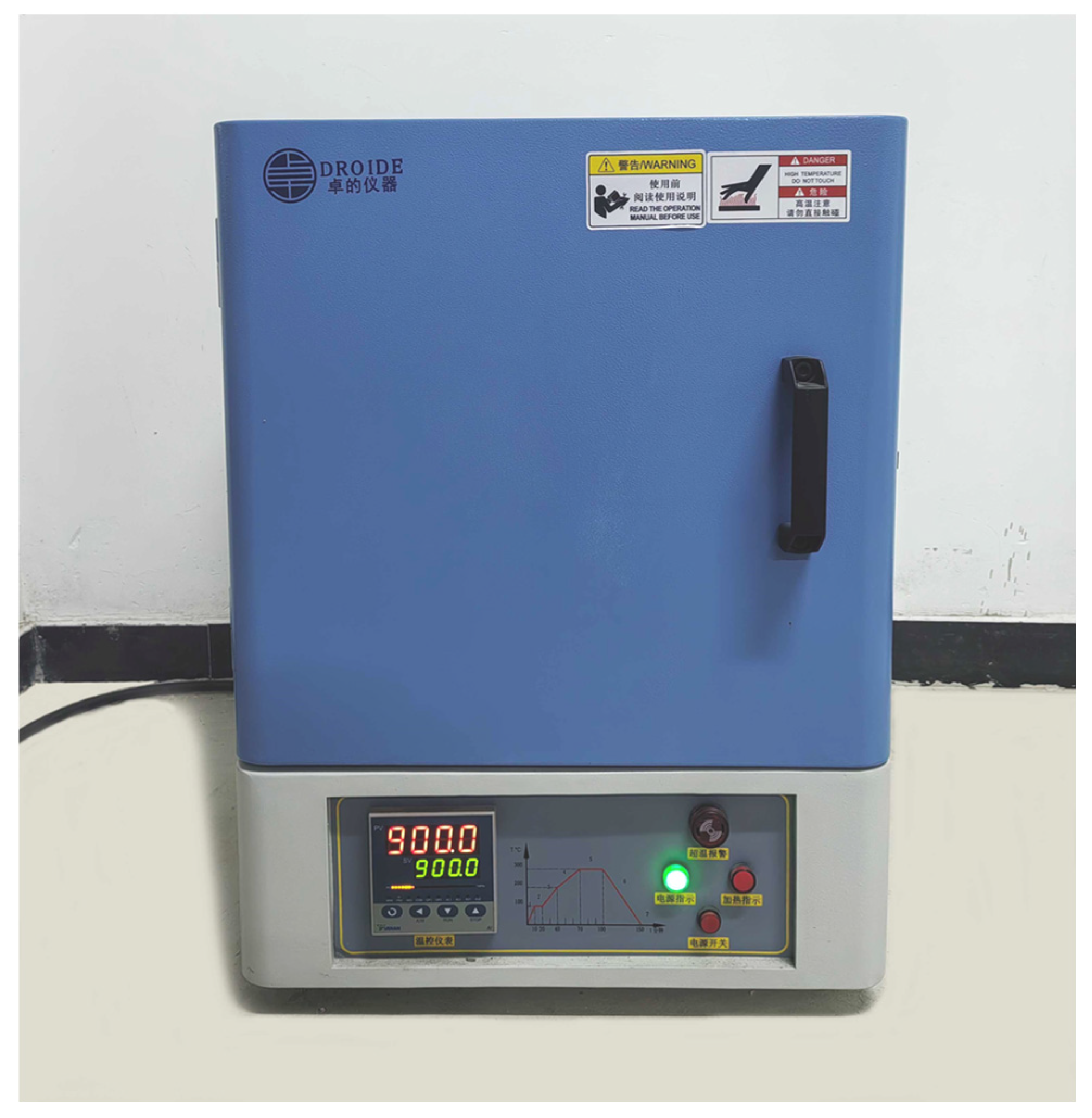






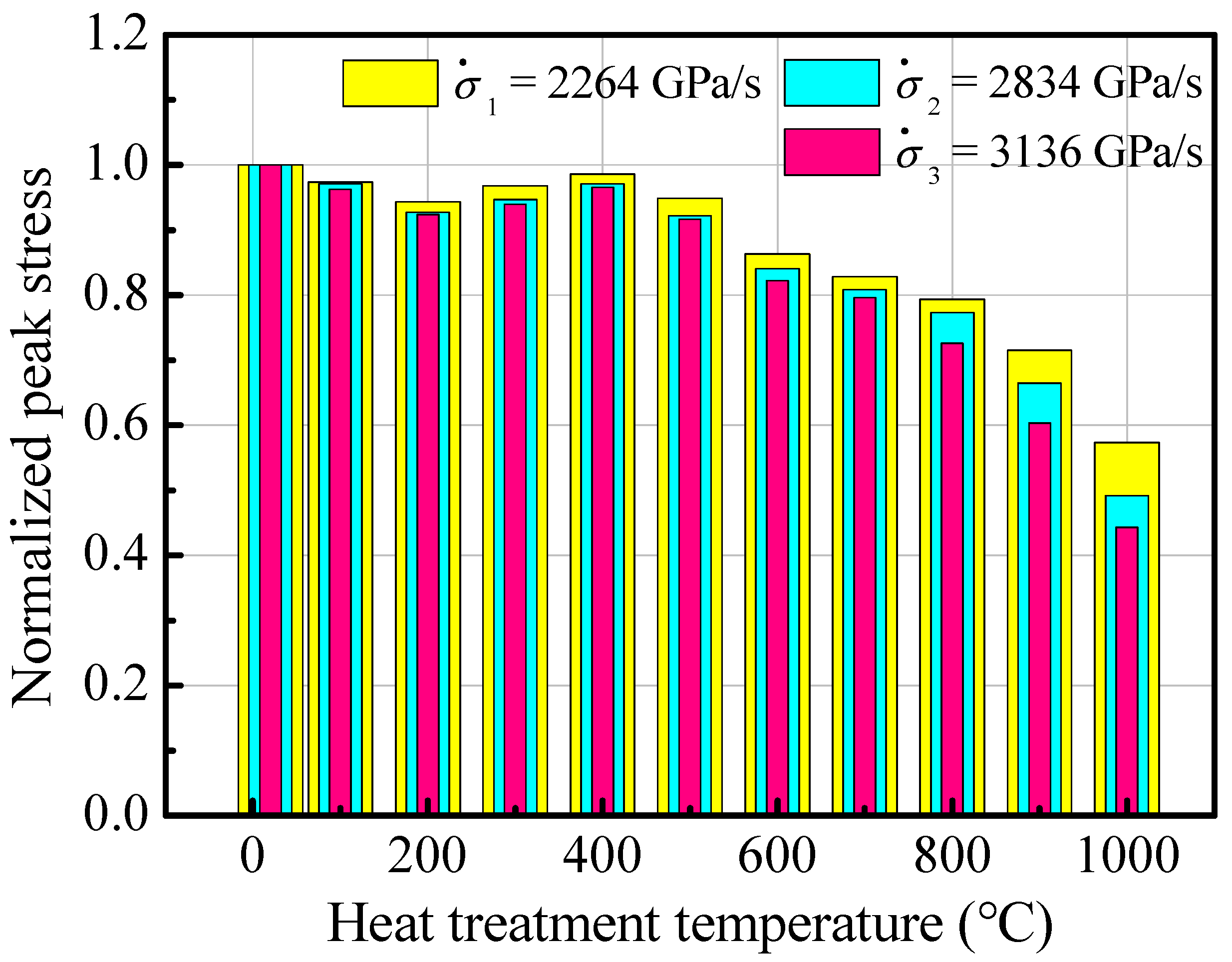
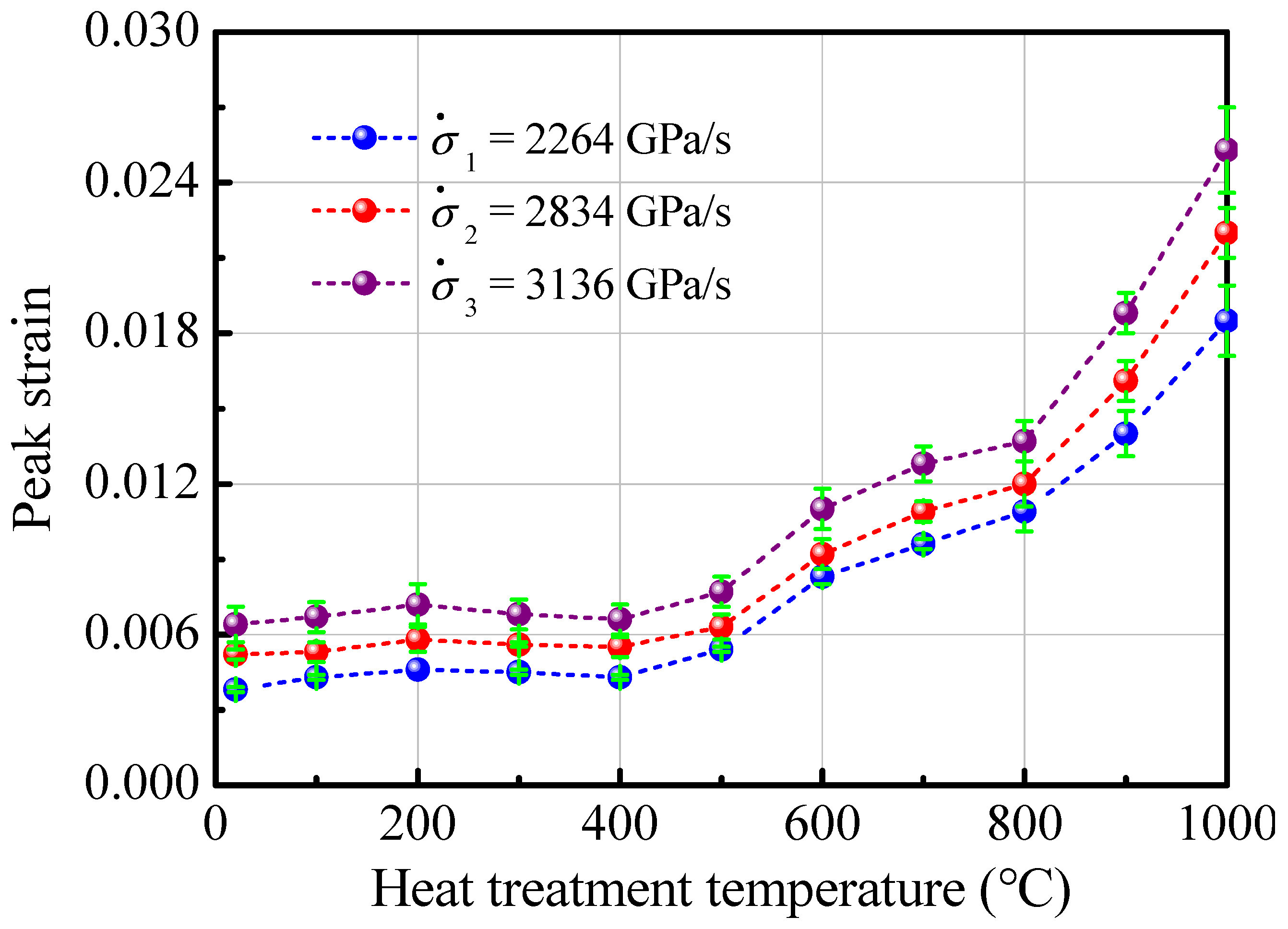
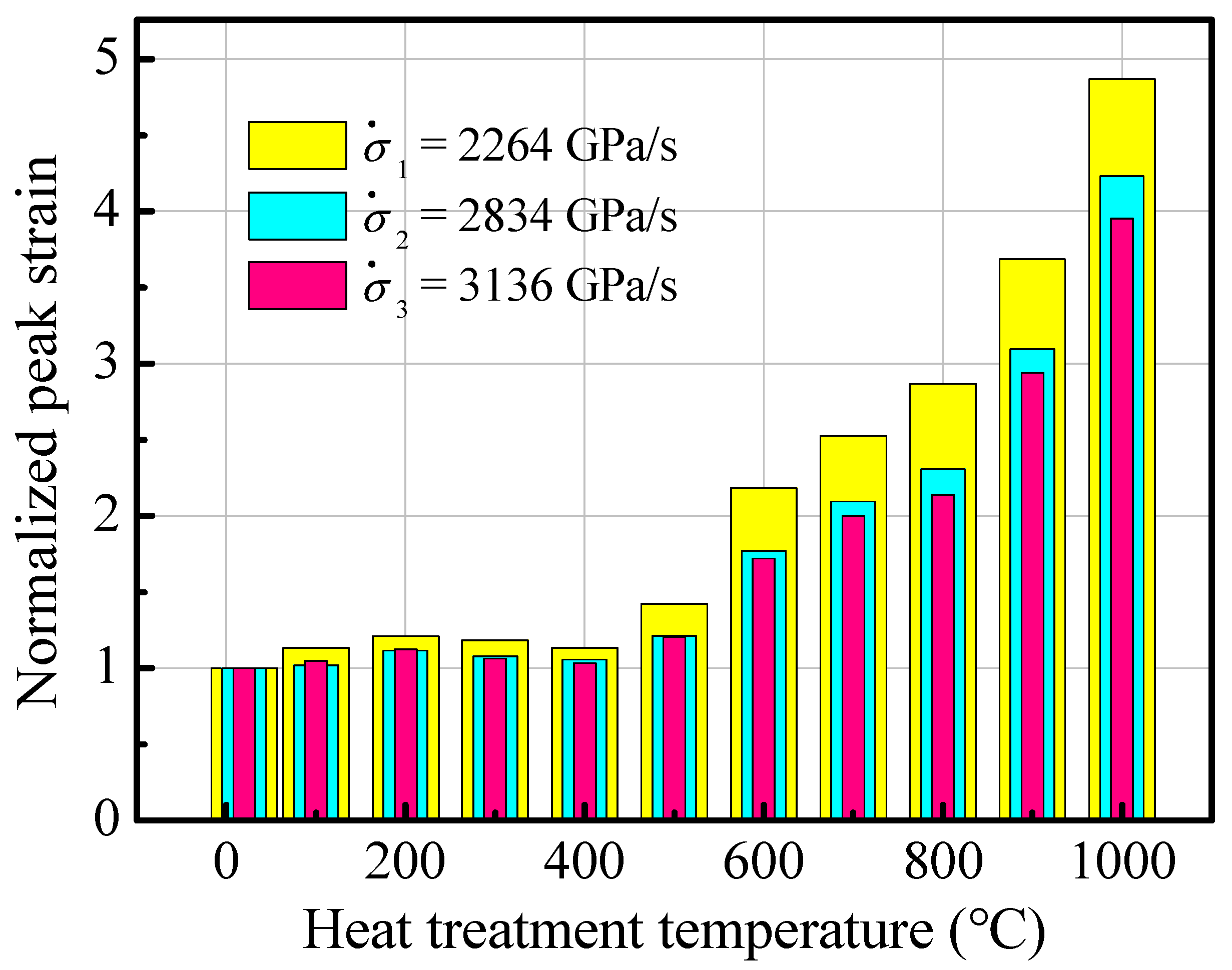
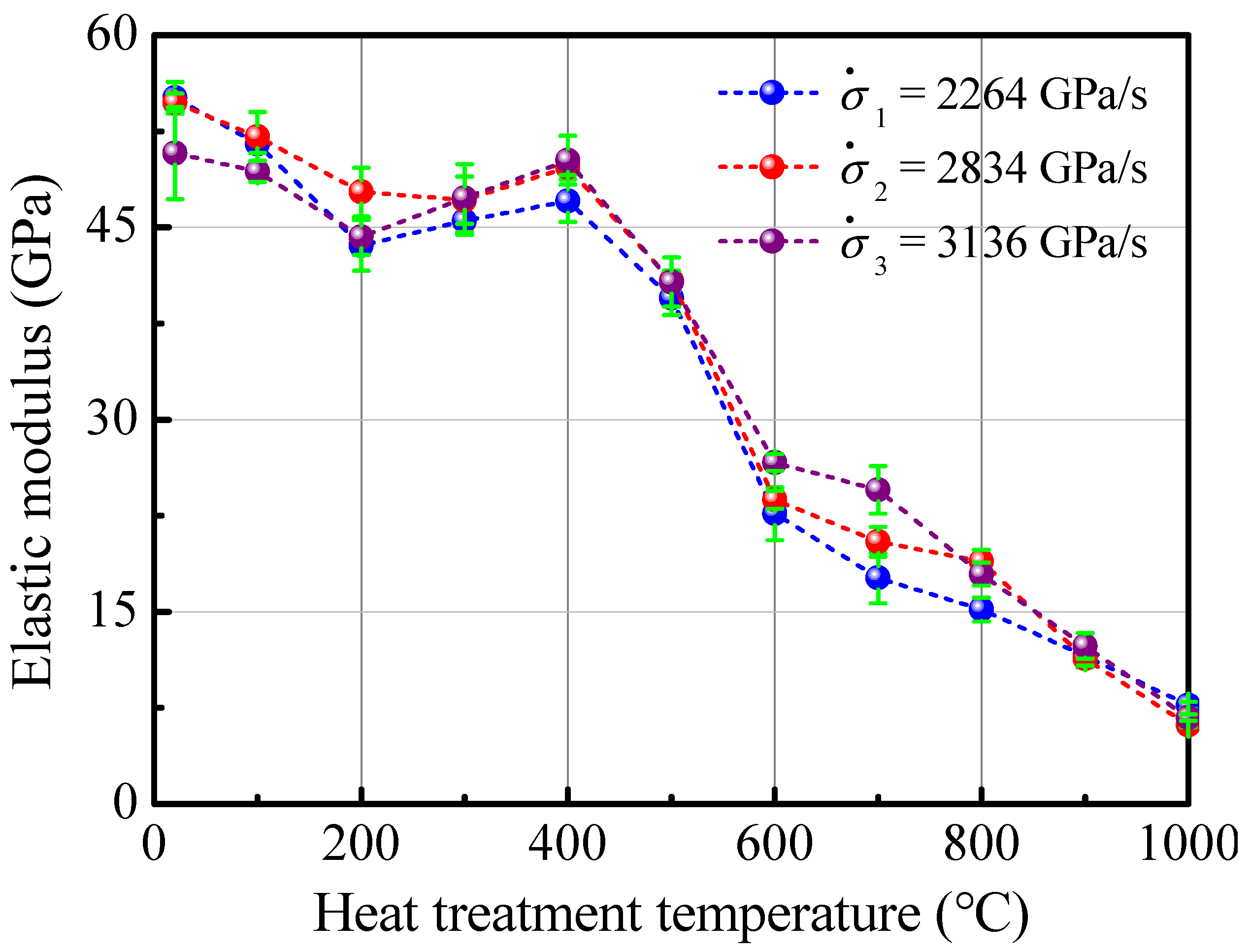
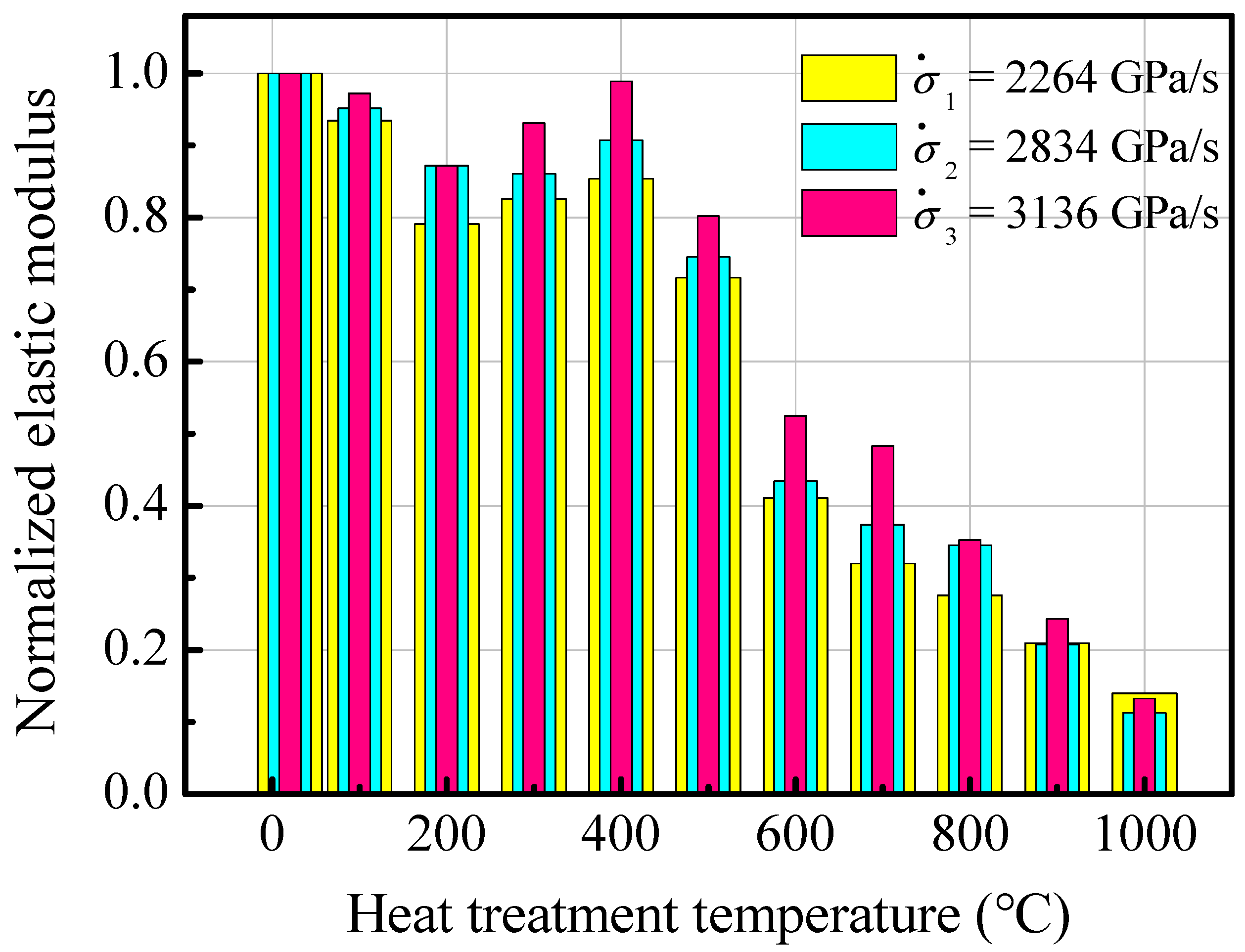
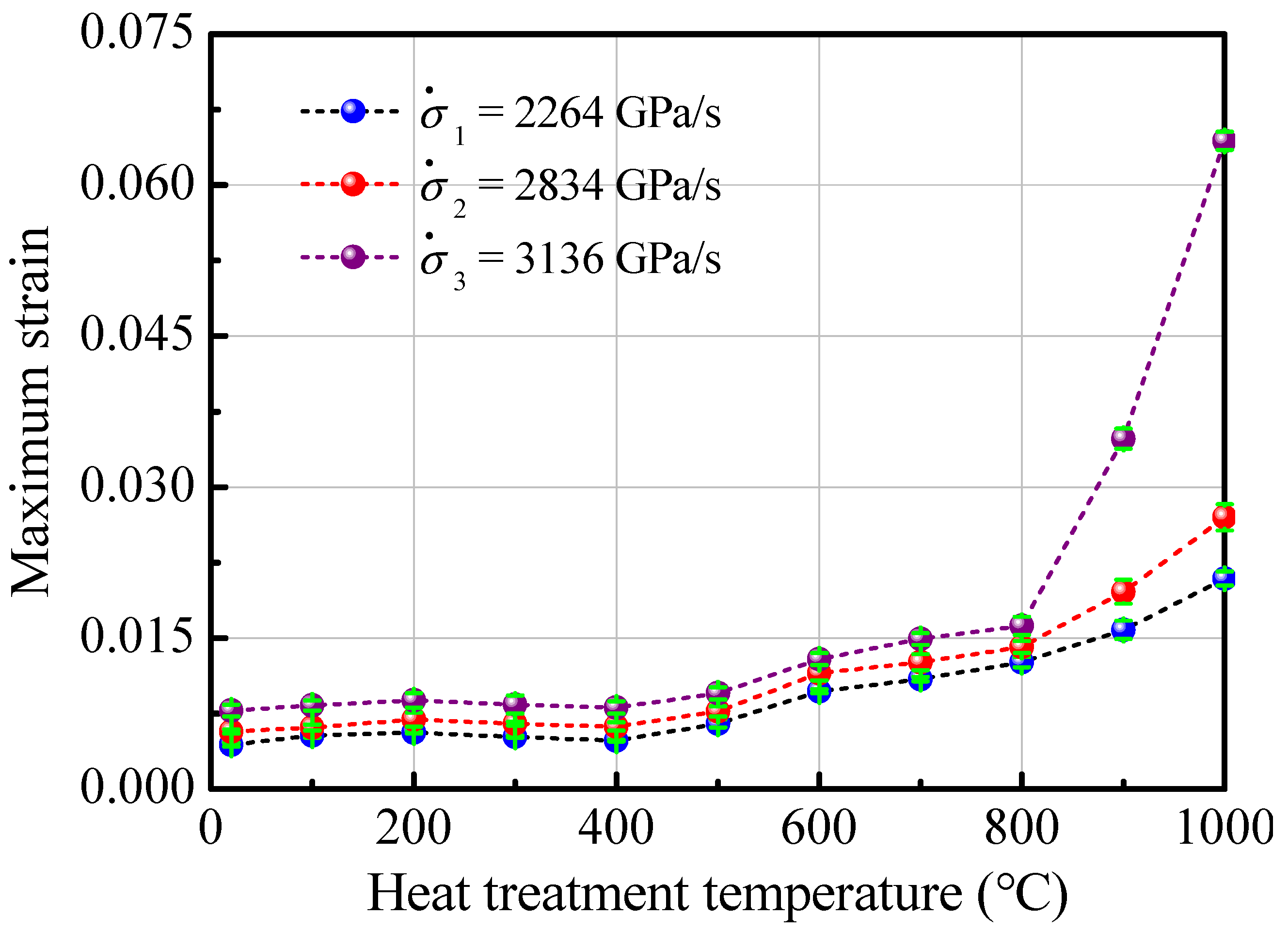

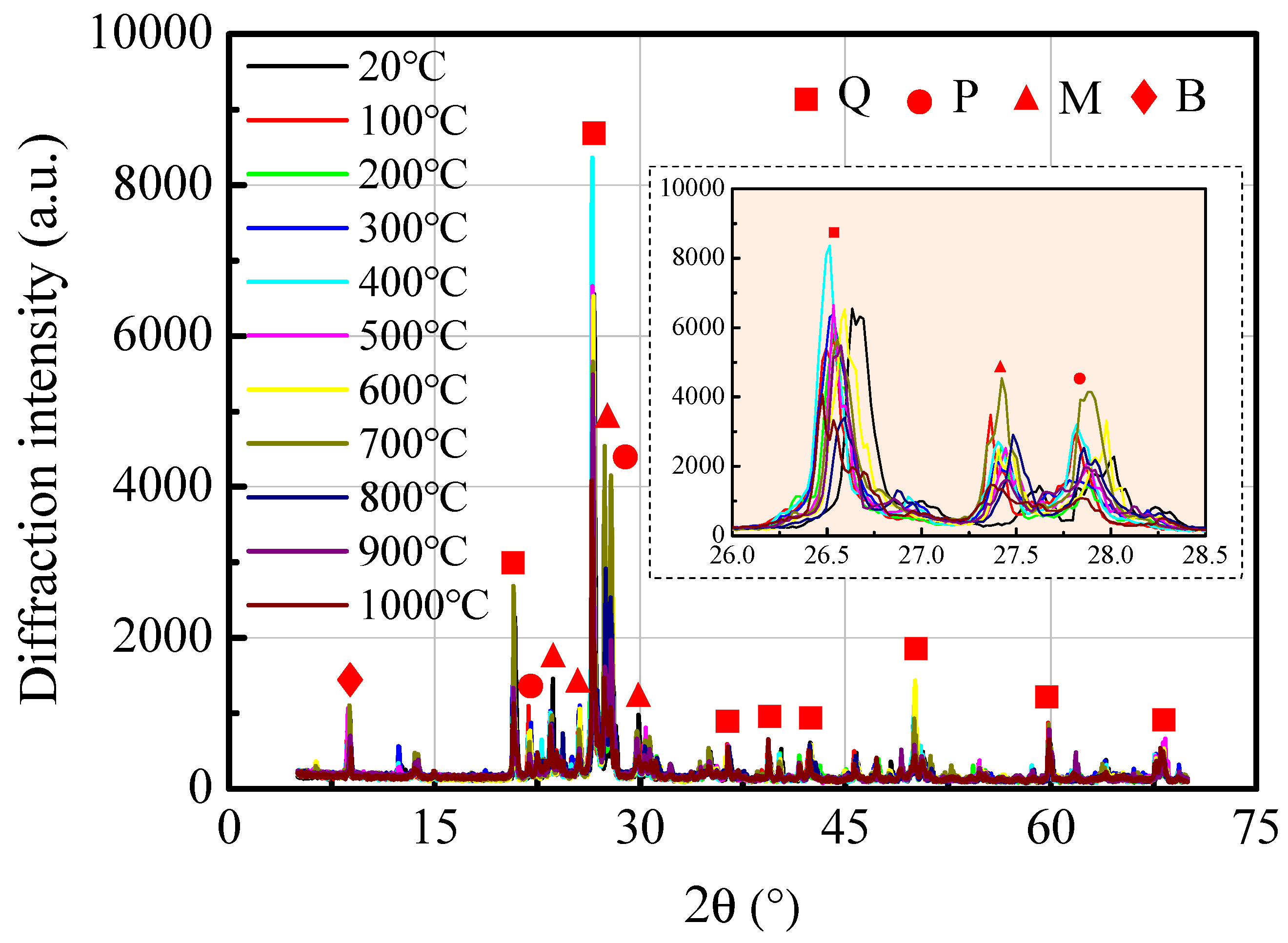
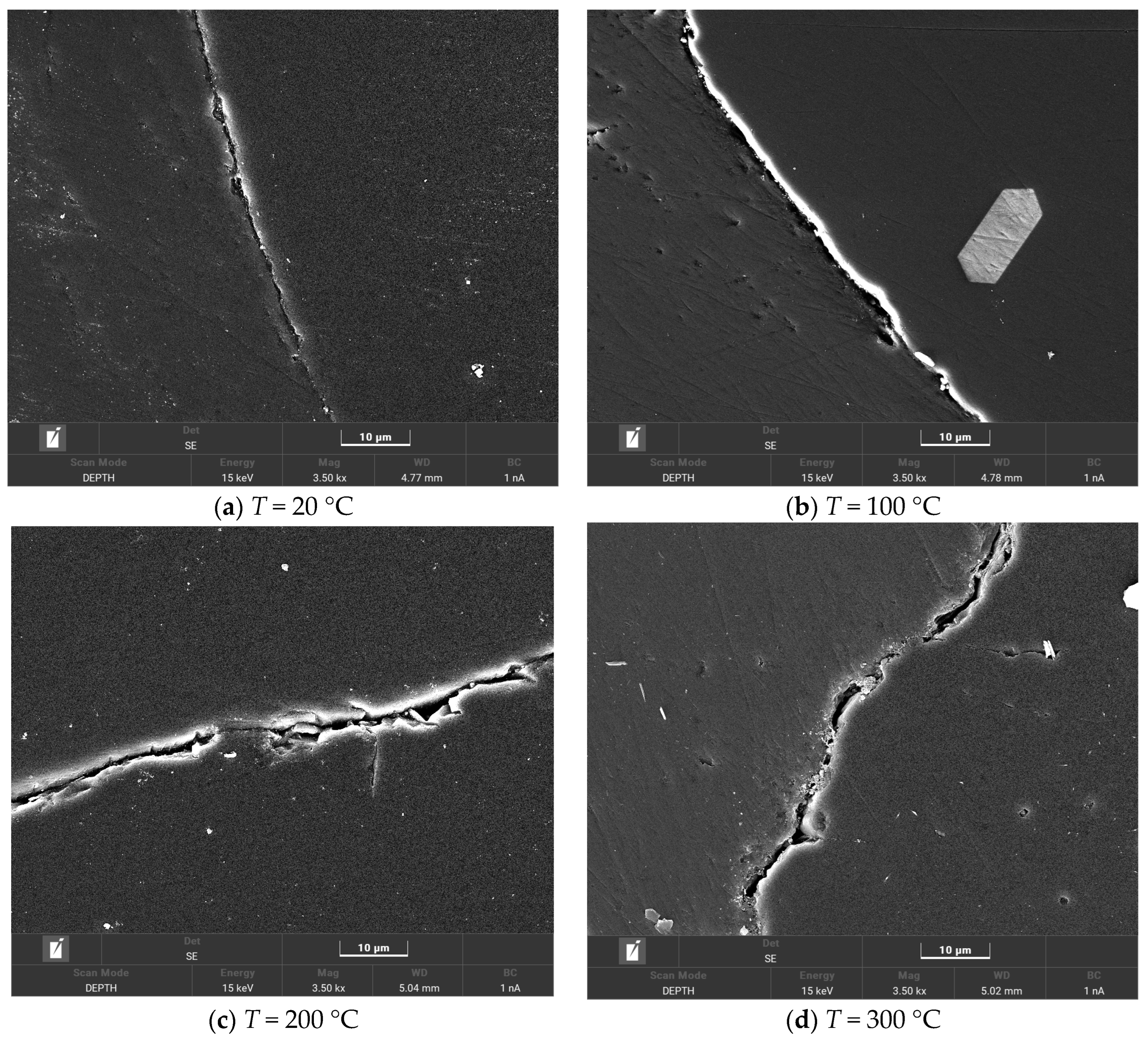
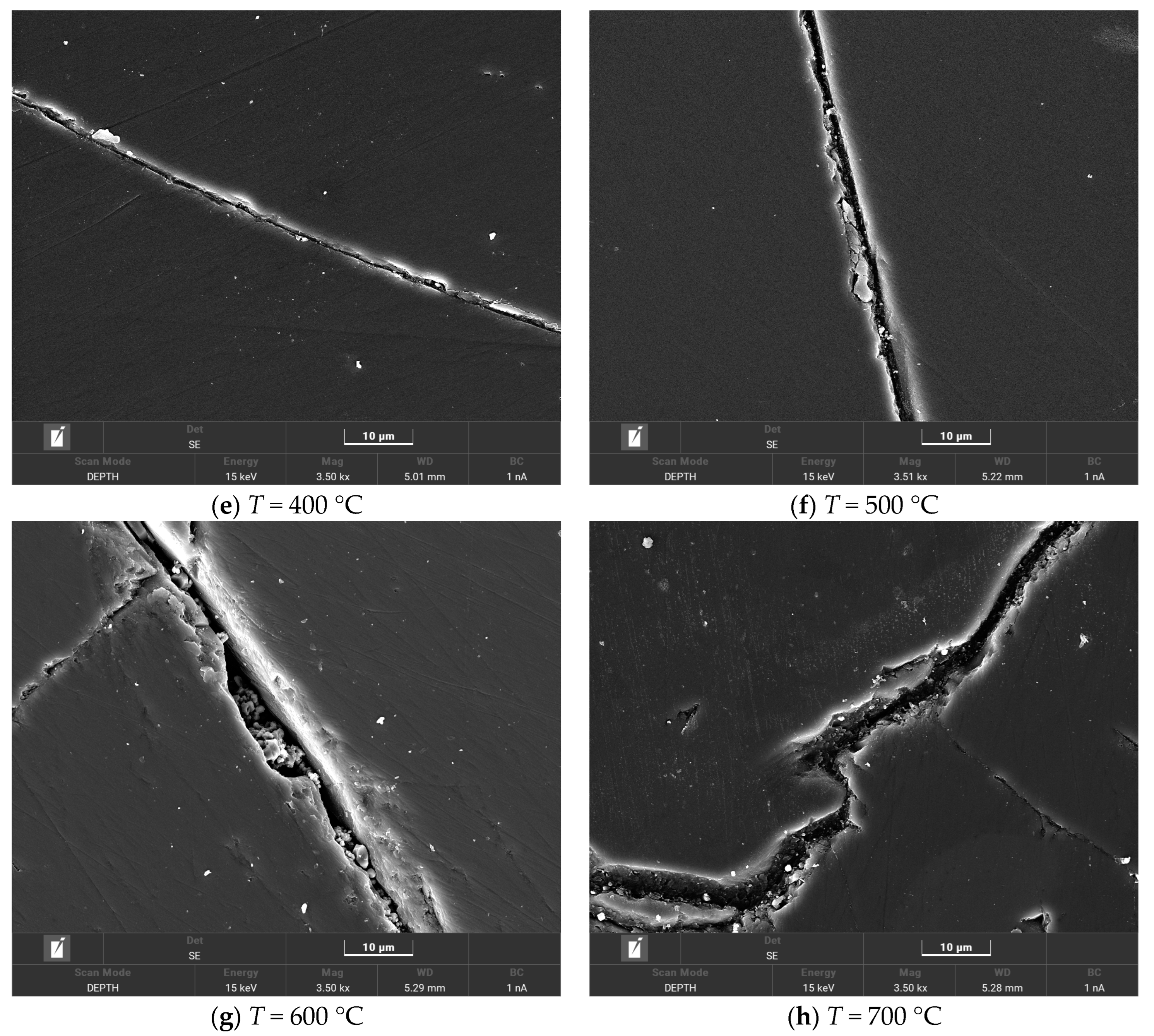

Disclaimer/Publisher’s Note: The statements, opinions and data contained in all publications are solely those of the individual author(s) and contributor(s) and not of MDPI and/or the editor(s). MDPI and/or the editor(s) disclaim responsibility for any injury to people or property resulting from any ideas, methods, instructions or products referred to in the content. |
© 2024 by the authors. Licensee MDPI, Basel, Switzerland. This article is an open access article distributed under the terms and conditions of the Creative Commons Attribution (CC BY) license (https://creativecommons.org/licenses/by/4.0/).
Share and Cite
Tian, N.; Hu, X.; Huang, K.; Chen, G.; Kong, H. Influence of Heat Treatment on the Mechanical Properties of Fine-Grained Granite under Dynamic Impact Loading. Buildings 2024, 14, 2272. https://doi.org/10.3390/buildings14082272
Tian N, Hu X, Huang K, Chen G, Kong H. Influence of Heat Treatment on the Mechanical Properties of Fine-Grained Granite under Dynamic Impact Loading. Buildings. 2024; 14(8):2272. https://doi.org/10.3390/buildings14082272
Chicago/Turabian StyleTian, Nuocheng, Xiaoyong Hu, Kai Huang, Guolong Chen, and Hongliang Kong. 2024. "Influence of Heat Treatment on the Mechanical Properties of Fine-Grained Granite under Dynamic Impact Loading" Buildings 14, no. 8: 2272. https://doi.org/10.3390/buildings14082272
APA StyleTian, N., Hu, X., Huang, K., Chen, G., & Kong, H. (2024). Influence of Heat Treatment on the Mechanical Properties of Fine-Grained Granite under Dynamic Impact Loading. Buildings, 14(8), 2272. https://doi.org/10.3390/buildings14082272





